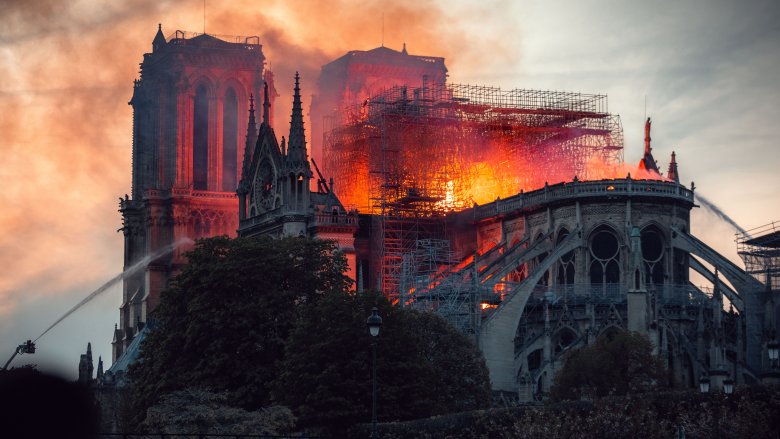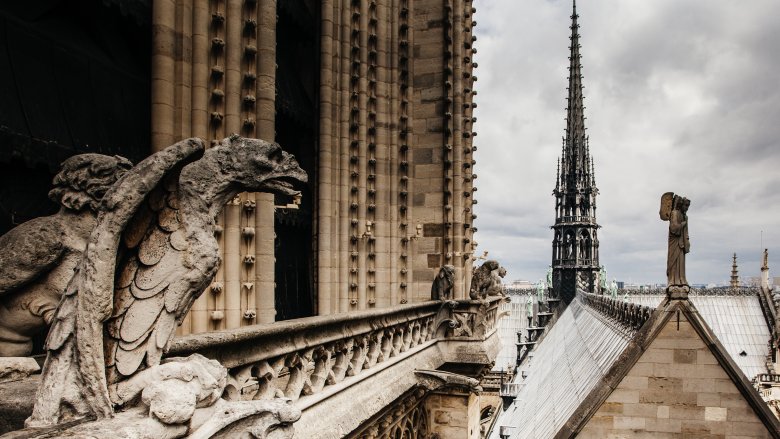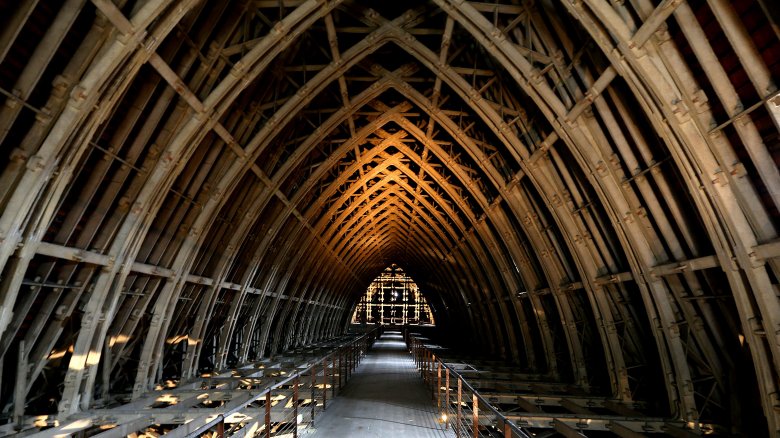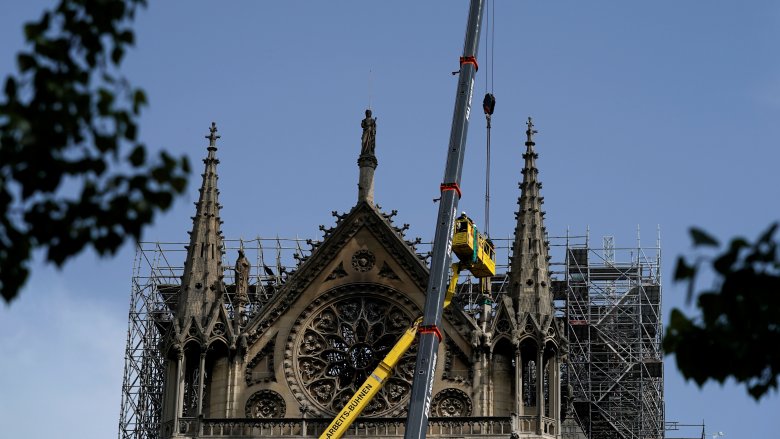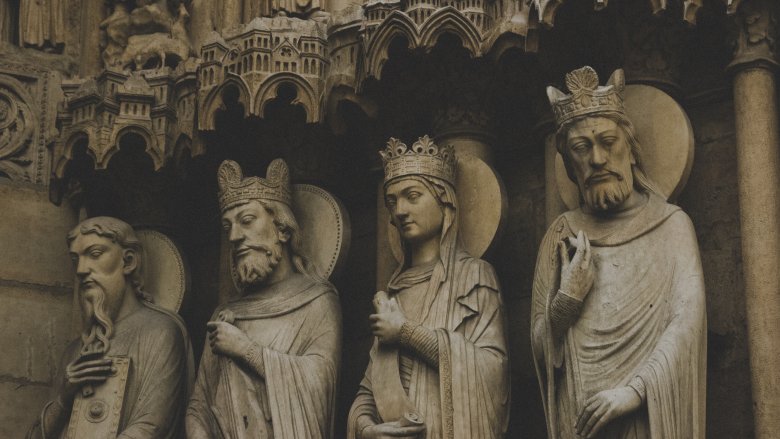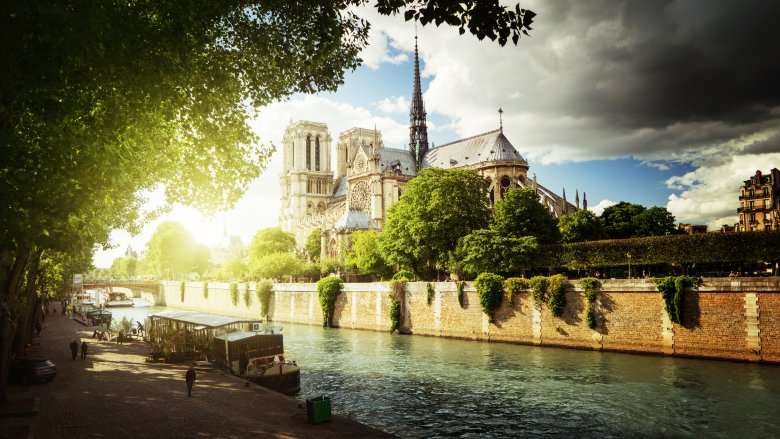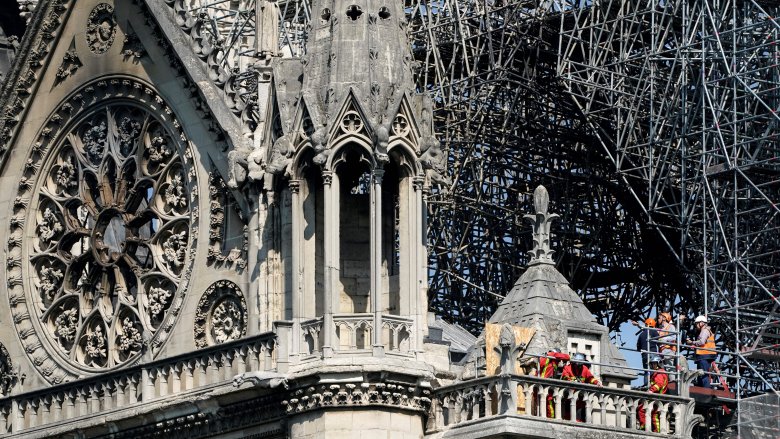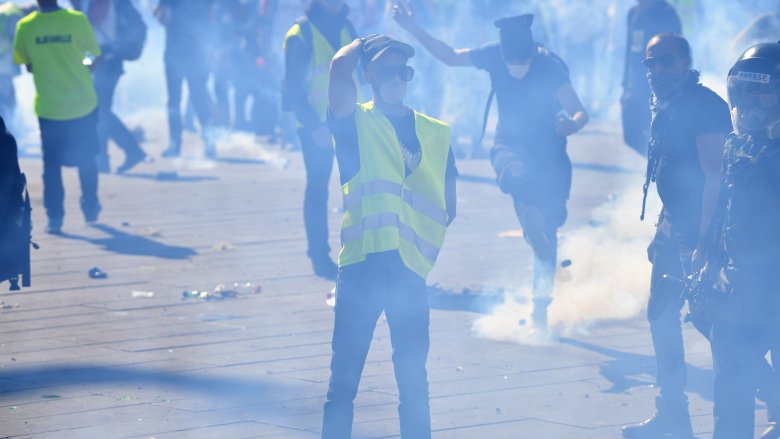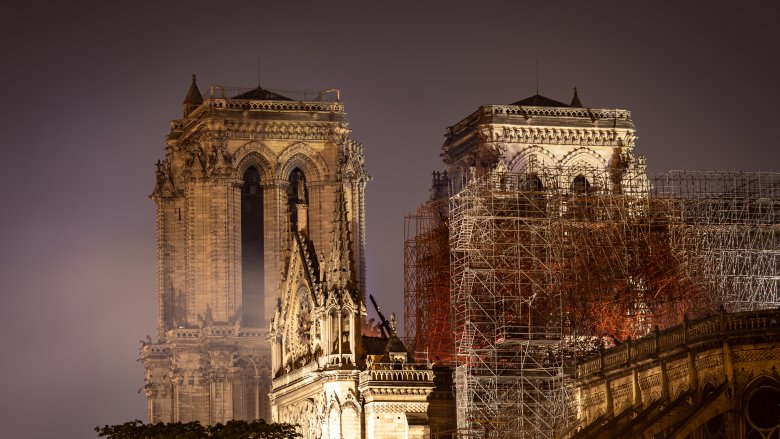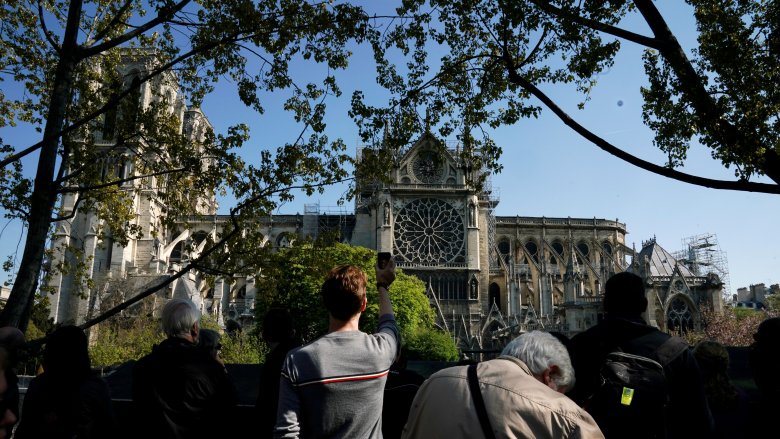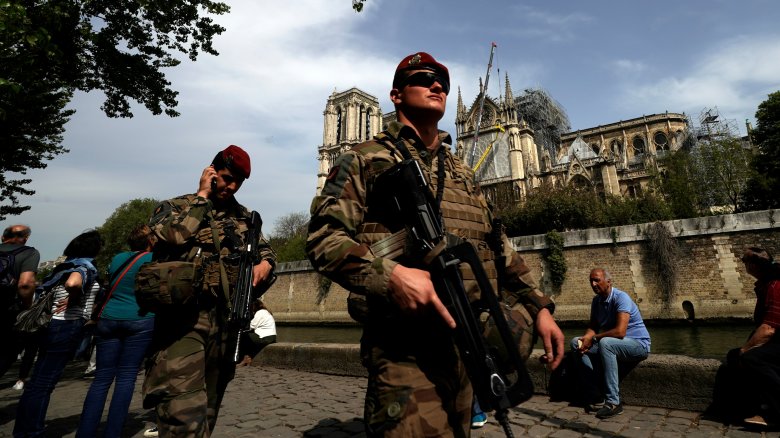The Worst Part Of Notre Dame's Near-Destruction Isn't What You Think
On April 15, 2019, the world watched in horror as one of Europe's most famous landmarks was engulfed in flames. Notre Dame was the home of dozens and dozens of centuries-old artifacts and priceless works of art, but it is also arguably the beating heart of French culture and spirituality. It took 12 hours for firefighters to bring the blaze to an end, as the world watched and lamented what many believed to be the worst part: that it had happened at all. But when you dig into the details, it gets even worse.
Once the ash and soot settled, the media began reporting on what was lost and what was saved — and the Independent was also reporting that there had been only a single injury: One firefighter was pretty badly hurt. Given how many people visit Notre Dame each and every year, that's incredible.
As everyone looked to France, the Guardian looked at the outpouring of sympathy and grief, and they noticed something incredible, best exemplified by one woman in tears. "On our watch, we let it burn," she said. The feeling was one of collective shame, and it suggests that people bore the brunt of the responsibility together — and that's important. It means that even in today's world, centered on the individual, there's still a sense of community and collective responsibility out there, and that's inspiring. Unfortunately, there are also a lot of really, really bad things that came out of the fire, too.
It was inevitable
The fire that tore through Notre Dame was a tragedy; there's no denying that. But, here's the thing. Those responsible for maintaining the landmark knew that tragedy of some catastrophic, structural kind was inevitable, and they had known it was inevitable for years.
In 2013, Didier Dupuy was hired to install lightning rods. When he scaled the building, he found an inner structure that had been neglected to the point where a repair job that was supposed to take right around two weeks stretched into three months, at which point he got so frustrated that he quit.
The Wall Street Journal chronicled the decay, and it's heartbreaking. There were holes and cracks in the roof, the buttresses were weakening, and the spire was rotten. Two years after Dupuy's assessment, American art historian Andrew Tallon documented the extent of the disrepair by using lasers to create a replica of the structure. Air pollution was eating away at the limestone, and one buttress was so far gone there was an imminent risk of wall collapse. Gargoyles had been propped up with pipes. So many pieces of stone had fallen off that those working on the eventual restoration dubbed it "a graveyard for architecture." And that rooster-shaped weathervane? It was already broken.
Years went by and restoration was eventually begun, but one could argue that it never should have been neglected so badly or gotten to that point in the first place.
The end of the Forest
One of the reasons the fire was so bad is that it had a ton of fuel. According to CNN, the flames ate through the entire wooden interior of the cathedral, and the wood frames were completely lost.
That sounds like it's just a shame, but knowing the details of exactly what that wood structure was ... well, that makes it even worse. The latticework was known as the Forest, and each one of the beams was made from a different oak tree. When workers were cutting and clearing the forests for it, they were clearing acres of oak trees that were already old, and they were working in the 12th and 13th centuries. In order to be as big as the plans called for, each tree was between 300 and 400 years old when it was cut — meaning they had started growing back in the eighth and ninth centuries.
Oh — and there were around 13,000 of them in the rafters.
These were the very same rafters that Victor Hugo wrote about in The Hunchback of Notre Dame, and it gets still worse. According to Bertrand de Feydeau of the Fondation de Patrimoine (via National Post), it's impossible to recreate the structure as it once was for a heartbreaking reason: France no longer has oak trees of the size and scale of the thousands that were lost. That wooden structure was as priceless and as irreplaceable as the cathedral's artwork.
It's happened before, and it'll happen again
Just a few days after the fire, CBS News was reporting that a computer glitch had probably been responsible for the fire. Details were scarce, but early information linked the fire to the work that was being done to restore the cathedral — and worse than Notre Dame burning alone is the fact that it's not the only landmark to be ravaged by fires started during restoration.
Several other French landmarks have had the same thing happen, and that's just in the last decade.
In 2013, Le Monde reported fire had destroyed a huge part of La Rochelle's town hall, a building that dated from the 15th and 16th centuries and housed treasures like the death mask of Henry IV. The fire was believed to be accidental from the beginning, and while most of the artwork was saved, huge sections of the building collapsed. Also ravaged by fire in 2013 was the 17th-century Hotel Lambert, causing damage the French minister of culture called "irreversible." The one-time home of Voltaire was largely unoccupied at the time, according to the Irish Times, because of the extensive renovations going on.
And here's the thing: Renovation-related fires are likely to happen again. In the wake of the Notre Dame fire, a fire safety review was ordered ahead of the massive renovations scheduled for St. Patrick's Cathedral in Dublin. According to the Irish Times, the conservationist overseeing the construction deemed fire risks to be "inevitable." So that's just lovely.
Think that damage was bad? Here, hold my beer
It took a century to build Notre Dame the first time, says the BBC, a process that started in the 1160s. While this 21st-century fire did a lot of damage, there's been a ton of damage already done to it in the previous centuries — and it wasn't all accidental.
Let's take just a few snapshots of the cathedral's history, starting with the Enlightenment in the 18th century. For Notre Dame, it began with a literal enlightenment, when in the 1750s the clergy decided that the stained glass windows were simply too dark and knocked them out to replace them with clear glass. While they were at it, they knocked down a bunch of the cathedral's statues, too. Three decades later, the 13th-century spire was looking a little ragged, so they simply got rid of it.
Fast-forward to the French Revolution. The church bells were melted, statues were decapitated, and the cathedral was turned into a warehouse. It didn't even become a church again until 1802. We have Napoleon to thank for that, but for a while, Notre Dame was on the brink of being torn down completely — changing trends meant it was viewed more as an eyesore than a valuable part of history and culture. It was only when the world rediscovered the beauty of Gothic architecture — and Victor Hugo wrote his masterpiece — that France actually sat up and took notice of Notre Dame again.
It's bringing out the scam artists
When tragedy happens on this scale, many people — good people — just want to help in some way, and that's great. In this situation, most people are doing that by donating to the costs of rebuilding and restoring the cathedral, but according to CBS News, that's also bringing out the worst in other people. Bad people.
Particularly, it's bringing out the scam artists.
Security experts have started warning the public about being extraordinarily careful how they donate money, partly because of how incredibly easy it is for anyone to set up a fake site or fundraiser claiming to be collecting donations to be routed to the cathedral. Scams include not just outright stealing donations, but also operating links that take people to legitimate charity sites and then pouring personal details and credit card information directly into scammers' hands.
And there are a huge number of them out there. Fortunately, some can be easy to spot, as questionable websites are usually anonymous, badly spelled, or slow to load because of bad coding. Of course, the fact that they're out there at all says volumes about just how horrible people can be.
The French people are on the hook
According to ABC News, Notre Dame and all of France's pre-1905 treasures belong to the French government. It's the government that's responsible for upkeep, maintenance, and — when something like this happens — restoration.
What about insurance money? There's not going to be much because Notre Dame isn't exactly insured. Why? There are a few factors. The landmark and its treasures are priceless, so it's next to impossible to even put a value on these things to insure them. Even if they did, the premiums would be so astronomical (if they could even find a private insurance company willing to take the risk) that the cost of repairing is — usually — lower than what they would pay in insurance. So huge entities — like governments — choose to "self-insure."
What does that mean? According to the insurers who spoke with Reuters just days after the blaze, it means France is going to be paying for the rebuild out of pocket, and it isn't going to be cheap. They were already comparing it to the costs of renovating the British Parliament building, which was estimated at $8 billion. For perspective, any liability insurance held by the contractor who had been renovating the cathedral would probably only pay out a sum in the tens of millions. As for the rest, anything not covered by donations is going to fall on the shoulders of the French people, and that's a terribly expensive burden to bear.
The Yellow Vests, protests, and a different sort of grief
Yes, Notre Dame is an important symbol of France and their cultural landscape and yes, hearing about so many people pledging so much money to help with the rebuilding of that landmark is pretty incredible. The Associated Press was reporting that millions had been raised in just a matter of hours, and it wasn't long before Sky News was reporting that donations had passed the billion mark.
But here's the thing. The day Notre Dame burned, there had been a protest scheduled. According to DW, it was the 23rd week of protests that have often turned violent and have led to conflicts between thousands of the so-called yellow vest protesters and thousands of police officers. At the heart of it all? Income inequality.
And it's a huge deal. During the first weekend of protests alone, around 290,000 people donned high-visibility vests and marched to condemn a wide range of policies implemented by President Emmanuel Macron's government, policies said to give huge advantages to the already-wealthy elite. The speed at which Macron addressed the tragedy at Notre Dame only added fuel to the fire, so to speak, as protesters pointed out that he hadn't even acknowledged them until after weeks of protests. The movement's spokesperson, Ingrid Levasseur, summed it up this way: "They can mobilize a truckload of cash in one night for Notre Dame, but they can't help the poor."
And that is terrible to see.
They had no fire suppression equipment, and that was intentional
When the blaze started, well, blazing, it took firefighters 12 hours to control the flames. According to the New York Times, part of the problem in fighting the fire was that the cathedral had none of the fire-prevention safeguards that are pretty fundamental in most places here in the 21st century.
Not only were there were no sprinkler systems and no firewalls, but officials had made a conscious decision to omit those very, very important elements. Pierre Housieaux of the Paris Historical Association has said that in spite of the fact everyone was well aware of just how fragile — and flammable — the wood structure of the cathedral was, they had never installed electrical components for two reasons: They were deemed a high-risk addition, and no one wanted to alter the cathedral's design.
And when it comes to that, Notre Dame is an anomaly. Historic structures across Europe are required by law to be altered enough to include fire safety measures of the type that would have saved a huge part of the cathedral's structure. Most people don't need an expert to tell them that if there had been fire-fighting equipment installed, the outcome of the fire would have been very different.
Other historical landmarks are rotting while Notre Dame gets attention
All the donations Notre Dame has received are definitely heartwarming to some, but there's one big problem with them. There are thousands of other churches in France that need the money just as badly.
According to the Guardian, there are an estimated 5,500 French churches that are in desperate need of repairs. Take the church of Saint Louis in La-Roche-sur-Yon. They desperately need money to install a fire alarm and restore their bells and belfries, but will they get it? Probably not. It's a story that plays out over and over across the country.
And while restoring a national landmark like Notre Dame is certainly important for the country, all those churches are just as important for the people who live in their shadows. A restored historical landmark could go a long way in revitalizing a small town. Think of it this way. A shocking number of billionaires have pledged hundreds of millions of dollars to Notre Dame. La-Roche-sur-Yon's church has a repair bill of just around $7 million. It's pocket change to those billionaires, but to the everyman, it's a fortune.
And even when the government does try to raise money for restoration projects, it's still on the shoulders of the country's poorest. In 2018, the Guardian reported a national lottery would be established to raise money to help save some of the country's most historic properties. Even then, only a fraction of those in need would benefit.
It showed just how quickly misinformation and conspiracy theories blossom
Even from the beginning, the mainstream media was reporting that experts were saying it was likely an accident.
That's it. An accident. But it didn't take long for the conspiracy theories to start, and from there, it got even worse. It turned into outright hate-mongering led by sites like InfoWars, who claimed that not only was it deliberately set, but that they had proof of people celebrating the fire. Misinformation spread faster than the fire itself had, along with claims that it was an act of terrorism. Numerous minority groups were blamed — in spite of the fact those who were actually at the site said it was an accident.
The Daily Beast tracked a huge part of the problem back to one tweet. It came from an aspiring U.S. politician named Christopher J. Hale, and it suggested that he had heard from a friend that the fire had been set intentionally. Literally — that was it. That was all the proof some people needed to go into overdrive, and even though Hale followed that up with a disclaimer that he had zero evidence it was true and deleted the tweet, the damage had been done. The tweet was used as "proof" by others, and the machine was in motion. And that's heartbreaking. The internet can be used for powers of good, but the fire showed how quickly it can be used for powers of evil, too.
